20. Kinh Pháp Cú – Chương 20: Phẩm Chánh Đạo – The Path – Song ngữ
Dhammapada Sutta (The Path of Truth)
Kinh Pháp Cú
English: Bhikkhu Khantipalo & Sister Susanna, 1993
Vietnamese: Thích Minh Châu, 1996
Illustrated Photos: Venerable-mahasi-sayadaw
Compile: Lotus group
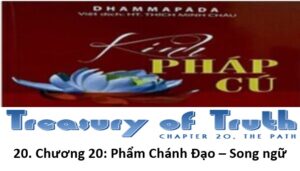
Chapter 20: Magga Vagga – The Path (Verse 273-289)
20. Kinh Pháp Cú – Chương 20: Giảng Lược Phẩm Chánh Đạo – Song ngữ
Verse 273. The Eight-fold Path Is Best
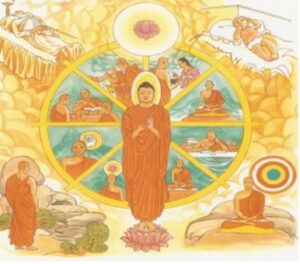
Of paths the Eight-fold is the best,
of truths the statement four,
the passionless of teachings best,
of humankind the Seer.
“Tám chánh, đường thù thắng,
Bốn câu, lý thù thắng.
Ly tham, pháp thù thắng,
Giữa các loài hai chân,
Pháp nhãn, người thù thắng.”
Explanation:
Of all paths the Eightfold Path is the best; of all truths the Four Noble Truths are the best; of all things passionlessness is the best; of men the Seeing One (the Buddha) is the best.
- Bát chánh đạo là đạo thù thắng hơn các đạo, Tứ đế là lý thù thắng hơn các lý, ly dục là pháp thù thắng hơn các pháp, cụ nhãn [22] là bậc thù thắng hơn các bậc thánh hiền.
Verse 274. The Only Path To Purity
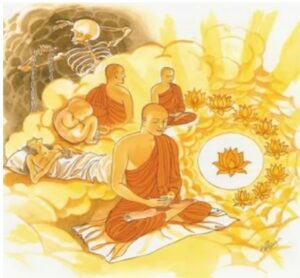
This is the path, no other’s there
for purity of insight,
enter then upon this path
bemusing Mara utterly.
“Ðường này, không đường khác
Ðưa đến kiến thanh tịnh.
Nếu ngươi theo đường này,
Ma quân sẽ mê loạn.”
Explanation:
This is the only path; there is none other for the purification of insight. Tread this path, and you will bewilder Mara.
- Chỉ có con đường này [23], chẳng còn con đường nào khác, có thể làm cho tri kiến các ngươi thanh tịnh. Các ngươi thuận làm theo thì bọn ma bị rối loạn.
Verse 275. The Path To End Suffering
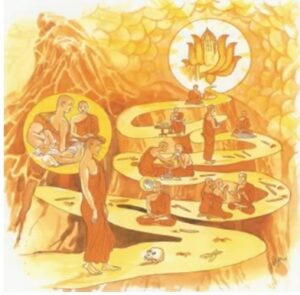
Entered then upon this path
you’ll make an end of dukkha.
Freed in knowledge from suffering’s stings
the Path’s proclaimed by me.
“Nếu người theo đường này,
Ðau khổ được đoạn tận.
Ta dạy người con đường.
Với trí, gai chướng diệt.”
Explanation:
Walking upon this path you will make an end of suffering. Having discovered how to pull out the thorn of lust, I make known the path.
- Các ngươi thuận tu theo Chánh đạo trên đây, thì khổ não sẽ dứt hết, và biết rằng đạo ta nói có sức trừ diệt chông gai [24].
Verse 276. Buddhas Only Shows The Way
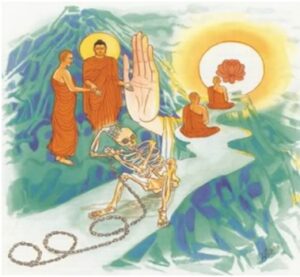
Buddhas just proclaim the Path
but you’re the ones to strive.
Contemplatives who tread the Path
are freed from Mara’s bonds.
“Người hãy nhiệt tình làm,
Như Lai chỉ thuyết dạy.
Người hành trì thiền định
Thoát trói buộc Ác ma.”
Explanation:
You yourselves must strive; the Buddhas only point the way. Those meditative ones who tread the path are released from the bonds of Mara.
- Các ngươi hãy nỗ lực lên! Như Lai chỉ dạy cho con đường giác ngộ. Sự trói buộc của ma vương sẽ tùy sức Thiền định của các ngươi mà được giải thoát.
Verse 277. Conditioned Things Are Transient

When with wisdom one discerns
transience of conditioned things
one wearily from dukkha turns
treading the path to purity.
“Tất cả hành vô thường ”
Với Tuệ, quán thấy vậy
Ðau khổ được nhàm chán;
Chính con đường thanh tịnh.”
Explanation:
“All conditioned things are impermanent” – when one sees this with wisdom, one turns away from suffering. This is the path to purification.
- “Các hành [25] đều vô thường [26]”; khi đem trí tuệ soi xét được như thế, thì sẽ nhàm lìa thống khổ. Đó là đạo thanh tịnh.
Verse 278. All Component Things Are Sorrow

When with wisdom one discerns
the dukkha of conditioned things
one wearily from dukkha turns
treading the path to purity.
“Tất cả hành khổ đau
Với Tuệ quán thấy vậy,
Ðau khổ được nhàm chán;
Chính con đường thanh tịnh.”
Explanation:
“All conditioned things are unsatisfactory” – when one sees this with wisdom, one turns away from suffering. This is the path to purification.
- “Các hành đều là khổ”; khi đem trí tuệ soi xét được như thế, thì sẽ nhàm lìa thống khổ. Đó là đạo thanh tịnh.
Verse 279. Everything Is Soul-less

When with wisdom one discerns
all knowables are not a self
one wearily from dukkha turns
treading the path to purity.
“Tất cả pháp vô ngã,
Với Tuệ quán thấy vậy,
Ðau khổ được nhàm chán
Chính con đường thanh tịnh.”
Explanation:
“All things are not-self” – when one sees this with wisdom, one turns away from suffering. This is the path to purification.
- “Các pháp đều vô ngã”; khi đem trí tuệ soi xét được như thế, thì sẽ nhàm lìa thống khổ. Đó là đạo thanh tịnh.
Verse 280. The Lazy Miss The Path
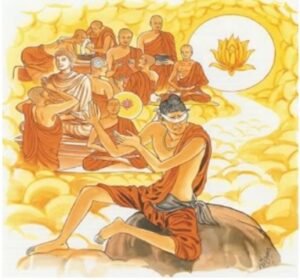
Though time to strive, not striving,
while young and strong yet indeed,
weak-minded and irresolute:
one finds not wisdom’s way.
“Khi cần, không nỗ lực,
Tuy trẻ mạnh, nhưng lười
Chí nhu nhược, biếng nhác.
Với trí tuệ thụ động,
Sao tìm được chánh đạo?”
Explanation:
The idler who does not exert himself when he should, who though young and strong is full of sloth, with a mind full of vain thoughts – such an indolent man does not find the path to wisdom.
- Khi đáng nỗ lực không nỗ lực, thiếu niên cường tráng đã biếng lười, ý chí tiêu trầm và nhu nhược; kẻ biếng nhác ấy làm gì có trí để ngộ đạo!
Verse 281. Purify Your Thoughts, Words And Deeds
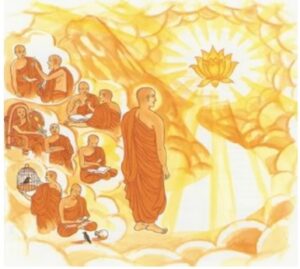
In speech ever watchful with mind well-restrained
never with body do unwholesomeness.
So should one purify these three kamma-paths
winning to the Way made known by the Seers.
“Lời nói được thận trọng,
Tâm tư khéo hộ phòng,
Thân chớ làm điều ác,
Hãy giữ ba nghiệp tịnh,
Chứng đạo Thánh nhân dạy.”
Explanation:
Let a man be watchful of speech, well controlled in mind, and not commit evil in bodily action. Let him purify these three courses of action, and win the path made known by the Great Sage.
- Thận trọng lời nói, kềm chế ý nghĩ, thân không làm ác, ba nghiệp thanh tịnh, là được đạo Thánh nhơn.
Verse 282. Way To Increase Wisdom
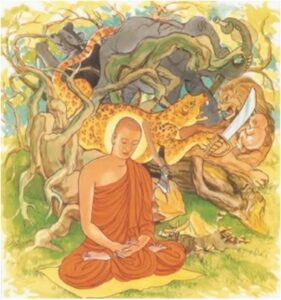
From endeavour wisdom springs,
lacking effort wisdom wanes:
having known this two-fold path
either to progress or decline
so should one exhort oneself
that wisdom may increase.
“Tu Thiền, trí tuệ sanh,
Bỏ Thiền, trí tuệ diệt.
Biết con đường hai ngả
Ðưa đến hữu, phi hữu,
Hãy tự mình nỗ lực,
Khiến trí tuệ tăng trưởng.”
Explanation:
Wisdom springs from meditation; without meditation wisdom wanes. Having known these two paths of progress and decline, let a man so conduct himself that his wisdom may increase.
- Tu Du già [27] thì trí phát, bỏ Du già thì tuệ tiêu. Biết rõ hai lẽ nầy thế nào là đắc thất, rồi nỗ lực thực hành, sẽ tăng trưởng trí tuệ.
Verse 283. Shun Passion
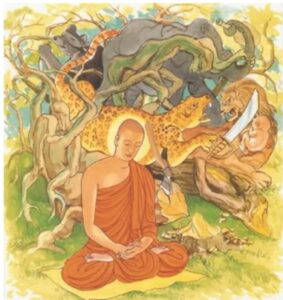
The wood cut down but not a tree
since it’s from wood that fear is born.
Having cut wood and woodedness
O bhikkhus be without a wood.
“Ðốn rừng không đốn cây
Từ rừng, sinh sợ hãi;
Ðốn rừng (1) và ái dục,
Tỷ kheo, hãy tịch tịnh.”
Explanation:
Cut down the forest (lust), but not the tree; from the forest springs fear. Having cut down the forest and the under-brush (desire), be passionless, O monks!
- Hãy đốn rừng dục vọng, chớ đốn cây thọ lâm; từ rừng dục vọng sinh sợ, hãy thoát ngoài rừng dục.
Verse 284. Attachment To Women

As long indeed as woodedness
of man to women is not cut
so long in bondage is one’s mind
as milch-calf to the mother cow.
“Khi nào chưa cắt tiệt,
Ái dục giữa gái trai,
Tâm ý vẫn buộc ràng,
Như bò con vú mẹ.”
Explanation:
For so long as the underbrush of desire, even the most subtle, of a man towards a woman is not cut down, his mind is in bondage, like the sucking calf to its mother.
- Sợi dây tình giữa trai gái chưa dứt, thì tâm còn bị buộc ràng như bò con chẳng rời vú mẹ.
Verse 285. Path To Peace
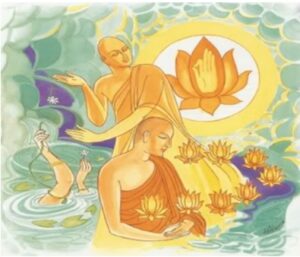
Cut off affection for oneself
as a hand a lily in the Fall.
Cultivate this peaceful path,
Nibbana by the Buddha taught.
“Tự cắt dây ái dục,
Như tay bẻ sen thu,
Hãy tu đạo tịch tịnh,
Niết-Bàn, Thiện Thệ dạy.”
Explanation:
Cut off your affection in the manner a man plucks with his hand an autumn lotus. Cultivate only the path to peace, Nibbana, as made known by the Exalted One.
- Tự mình dứt hết ái dục như lấy tay bẻ cành sen thu, siêng tu đạo tịch tịnh. Đó là Niết bàn mà đức Thiện Thệ [28] đã truyền dạy.
Verse 286. The Fear Of Death
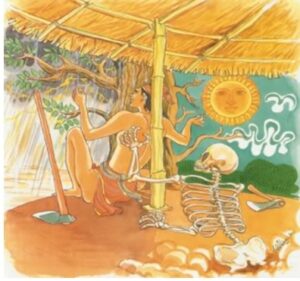
Here shall I spend the Rains,
here the Winter, here the Summer.
Thus speculates the fool,
the danger he knows not.
“Mùa mưa ta ở đây
Ðông, hạ cũng ở đây,
Người ngu tâm tưởng vậy,
Không tự giác hiểm nguy.”
Explanation:
“Here shall I live during the rains, here in winter and summer” – thus thinks the fool. He does not realize the danger (that death might intervene).
- “Mùa mưa ta ở đây, đông, hạ, ta cũng ở đây”, đấy là tâm tưởng của hạng người ngu si, không tự giác những gì nguy hiểm.
Verse 287. Death Takes Away The Attached
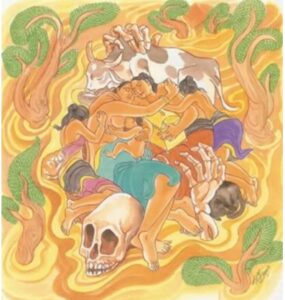
For one who has a clinging mind
and finds delight in babes and herds
Death does seize and carry away
as great flood a sleeping village.
“Người tâm ý đắm say
Con cái và súc vật,
Tử thần bắt người ấy,
Như lụt trôi làng ngủ.”
Explanation:
As a great flood carries away a sleeping village, so death seizes and carries away the man with a clinging mind, doting on his children and cattle.
- Người đắm yêu con cái và súc vật, thì tâm thường mê hoặc, bị tử thần bắt đi, như xóm làng đang say ngủ, bị cơn nước lũ cuốn trôi.
Verse 288. No Protection When Needed

No sons are there for shelter
nor father nor related folk,
one by the Death-king seized upon
in kin no shelter finds.
“Một khi tử thần đến,
Không có con che chở,
Không cha, không bà con,
Không thân thích che chở.”
Explanation:
For him who is assailed by death there is no protection by kinsmen. None there are to save him – no sons, nor father nor relatives.
- Một khi tử thần đã đến, chẳng thân thuộc nào có thể thay thế, dù cha con thân thích cũng chẳng làm sao cứu hộ.
Verse 289. The Path To The Deathless
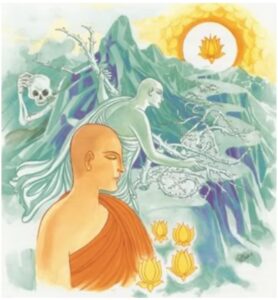
Having understood this fact
the wise by virtue well-restrained
swiftly then should clear the path
leading to Nibbana.
“Biết rõ ý nghĩa này,
Bậc trí lo trì giới,
Mau lẹ làm thanh tịnh,
Con đường đến Niết-Bàn.”
Explanation:
Realizing this fact, let the wise man, restrained by morality, hasten to clear the path leading to Nibbana.
- Biết rõ lý lẽ trên người trí gắng trì giới, thấu hiểu đường Niết bàn, mau làm cho thanh tịnh.
Chú thích:
[22] Cụ nhãn: chỉ cho đức Phật, vì đức Phật có đủ năm mắt: nhục nhãn (mamsa- cakkhu), thiên nhãn (dibhacakkhu), huệ nhãn (Panna cakkhu), Phật nhãn (Buddha-cakkhu), Nhất thế trí nhãn (Samanta-cakkhu)
[23] Con đường này: chỉ cho Tứ Đế, Bát chánh đạo và Niết bàn.
[24] Trừ diệt chông gai: chỉ cho Tam độc: tham, sân, si.
[25] Các hành: chữ hành nguyên nghĩa đen của nó là đi, là di chuyển, biến động. Tức chỉ chung cho mọi hiện tượng sinh lý hay tâm lý đều biến dịch luôn luôn thay đổi, không thường còn, khác nào như một dòng nước chảy trôi.
[26] Vô thường: chỉ chung cho mọi sự vật trên thế gian này không thường còn với thời gian. Tất cả đều bị chi phối bởi thời gian, không có gì tồn tại.
[27] Du già: (yoga) tức là định. Đây là thuật luyện khí của Ấn Độ, gần giống như thuật luyện khí của Đạo Tiên.
[28] Thiện Thệ: là khéo vượt qua biển sanh tử đến Niết bàn. Thiện Thệ là một trong mười hiệu Phật. Mười hiệu Phật gồn có: Như Lai, Ứng Cúng, Chánh Biến Tri, Minh Hạnh Túc, Thiện Thệ, Thế Gian Giải, Vô Thượng Sĩ, Điều Ngự Trượng Phu, Thiên Nhơn Sư, Phật, Thế Tôn.

Sources:
Tài liệu tham khảo:
- http://thanhtruc-thanhtrucgdth.blogspot.com/2011/02/kinh-phap-cu.html
- http://www.buddhanet.net/dhammapada/d_path.htm
- https://www.pinterest.com/meditonindotcom/funny-meditation/
- Tam Tu Metta Buddhist Temple & Heritage Garden – 610 Fisher Ave, Morgan Hill, CA 95037
- https://quangduc.com/a29858/kinh-phap-cu-chu-giai-tap-3
